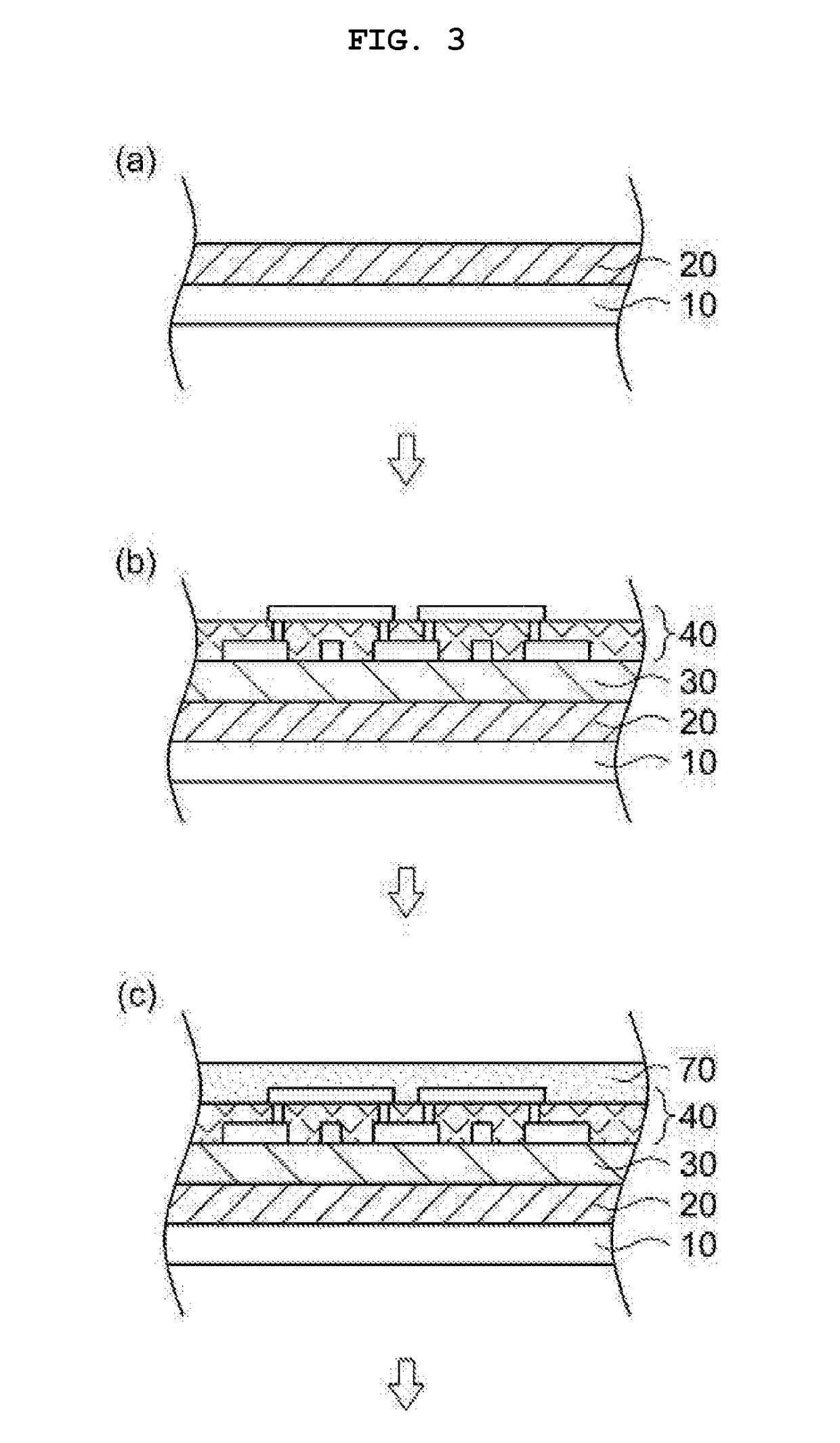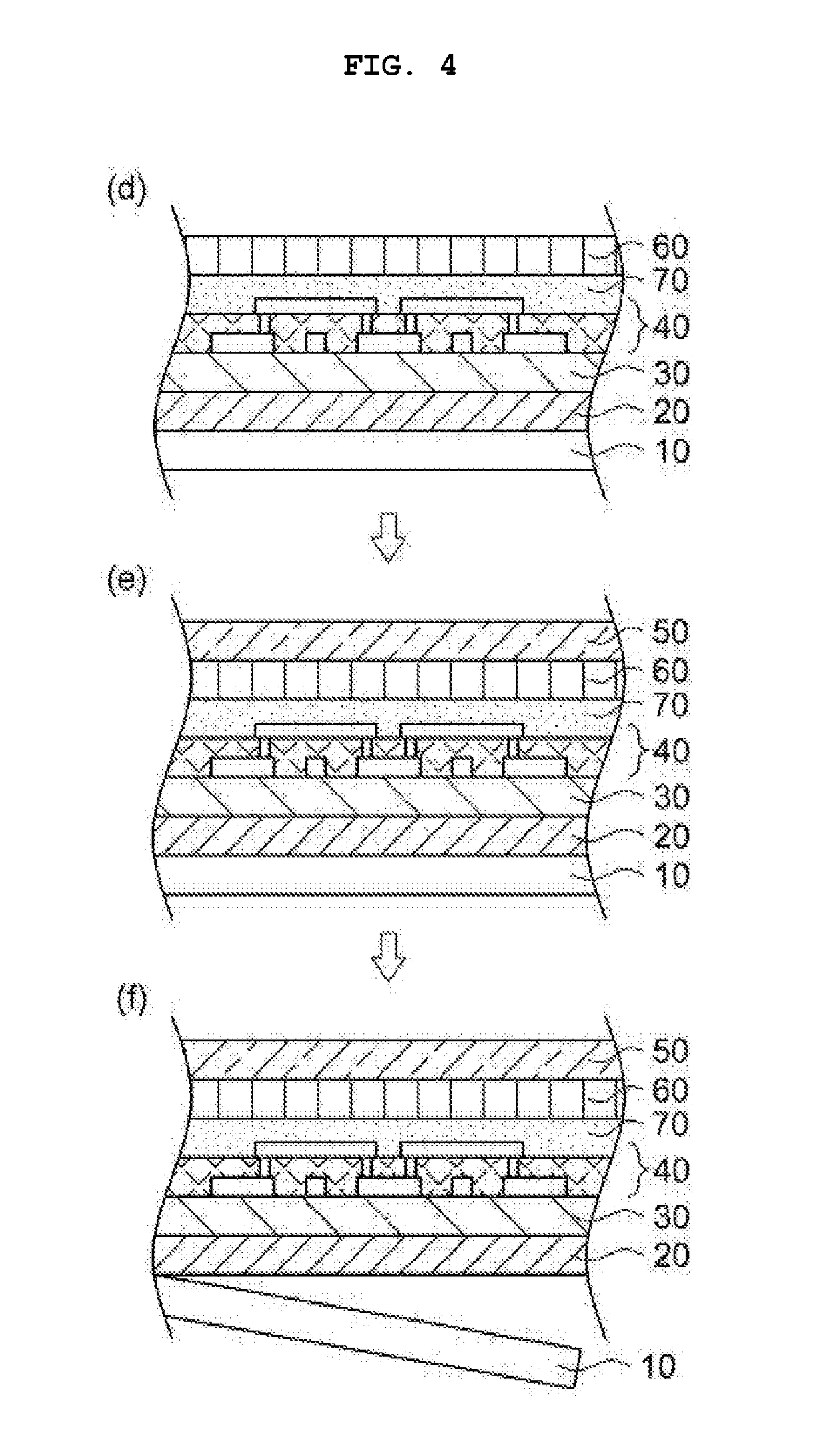Film touch sensor and method for fabricating the same
- Summary
- Abstract
- Description
- Claims
- Application Information
AI Technical Summary
Benefits of technology
Problems solved by technology
Method used
Image
Examples
synthesis example 1
[0192]60 parts of 8-hydroxycarbonyl tetracyclododecene, 40 parts of N-phenyl-(5-norbornene-2,3-dicarboxy imide), 1.3 parts of 1-hexene, 0.05 parts of (1,3-dimethyl imidazolidin-2-ylidene) (tricyclohexyl phosphine) benzylidene ruthenium dichloride, and 400 parts of tetrahydrofuran were put into a nitrogen-substituted glass pressure reactor, and reacted at 70° C. for 2 hours while stirring to obtain a resin solution (a) (solid concentration: about 20%). The resin solution (a) was transferred into an autoclave equipped with a stirrer, and reacted at a hydrogen pressure of 4 MPa and a temperature of 150° C. for 5 hours to obtain a resin solution (b) containing a hydrogenated resin (hydrogenation rate: 99%). Then, 100 parts of the resin solution (b) and 1 part of activated charcoal powders were put into an autoclave made of a heat-resistant agent, and reacted at 150° C. under a hydrogen pressure of 4 MPa for 3 hours. After completion of the reaction, the reactant was filtered with a filt...
synthesis example 2
[0203]100 parts of 8-methyl-8-methoxycarbonyl tetracyclo[4.4.0.12,5.17,10]dodeca-3-ene, 1.3 parts of 1-hexene, 0.05 parts of 1,3-dimethyl imidazolidin-2-ylidene(tricyclohexyl phosphine)benzylidene ruthenium dichloride, and 400 parts of cyclohexene were put into a nitrogen-substituted glass pressure to reactor. The mixture was subjected to polymerization reaction and hydrogenation reaction according to the same method as Synthesis Example 1 to obtain a resin (A). The resin (A) had an Mw of 5,300 and an Mn of 3,200. In addition, the hydrogenation rate was 99%. Next, 100 parts of the resin (A) obtained above, 100 parts of N-methyl pyrrolidone, 500 parts of propyleneglycol, and 84.5 parts of 85% potassium hydroxide were added to the reactor. The mixture was heated and stirred at 190° C. for 4.5 hours. The obtained reactant was poured into a mixed solution of a large amount of water, tetrahydrofuran and hydrochloric acid to coagulate the hydrolysate. The coagulated polymer was washed wit...
synthesis example 3
[0204]100 parts of 5-(2-hydroxyethoxycarbonyl) bicyclo[2.2.1]hepto-2-ene, 1.3 parts of 1-hexene, 0.05 parts of 1,3-dimethyl imidazolidin-2-ylidene(tricyclohexyl phosphine)benzylidene ruthenium dichloride, and 400 parts of tetrahydrofuran were put into a nitrogen-substituted glass pressure reactor. The mixture was subjected to polymerization reaction and hydrogenation reaction according to the same method as Synthesis Example 1 to obtain a resin (3). The resin (3) had an Mw of 5,500 and an Mn of 3,300. In addition, the hydrogenation rate was 99%.
PUM
| Property | Measurement | Unit |
|---|---|---|
| Temperature | aaaaa | aaaaa |
| Temperature | aaaaa | aaaaa |
| Glass transition temperature | aaaaa | aaaaa |
Abstract
Description
Claims
Application Information
 Login to View More
Login to View More - R&D
- Intellectual Property
- Life Sciences
- Materials
- Tech Scout
- Unparalleled Data Quality
- Higher Quality Content
- 60% Fewer Hallucinations
Browse by: Latest US Patents, China's latest patents, Technical Efficacy Thesaurus, Application Domain, Technology Topic, Popular Technical Reports.
© 2025 PatSnap. All rights reserved.Legal|Privacy policy|Modern Slavery Act Transparency Statement|Sitemap|About US| Contact US: help@patsnap.com



